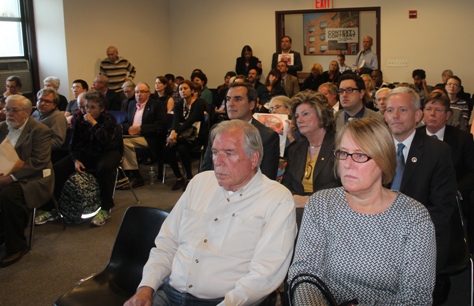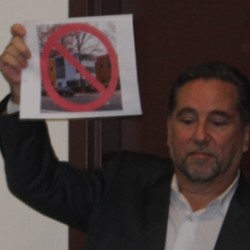
Hearing (Photo: SunnysidePost)
Oct. 17, 2013 By Christian Murray
At least 75 Sunnyside residents turned out in force to the Landmarks Preservation Commission Tuesday to voice their outrage about a proposed 8-unit apartment dwelling–accompanied by an architecturally significant aluminum house—that would be located within the confines of the Sunnyside Gardens Historic District.
The residents– who were joined by State Senator Mike Gianaris, Assemblywoman Marge Markey, Councilman Jimmy Van Bramer and Community Board 2 Chairman Joe Conley–told the Landmarks Preservation Commission that the Aluminaire House was completely out of character to the red-brick landmarked neighborhood—and that its inclusion defied the purpose of land marking, which is about uniformity.
The proposed development would take place on the corner of 39th Avenue and 50th Street, the site of the former Phipps playground, where many Sunnyside and Woodside residents played as children. With its old shed, sandbox pavilion and swings & slides still there, the playground is one of the only remaining depression-era playgrounds still in existence.
The Landmarks Preservation Commission has the final word on whether the development will be permitted to be built—and it is unclear when it will render its decision. A spokeswoman for the Commission said that a date has not been set and it is not clear whether a decision will be made any time soon.
The spokeswoman said that there is a great deal of public comment for the commission to review—as well as examining the intricacies of the proposal.
The Aluminaire House would be unoccupied and would essentially be a vacant architectural museum piece. The adjacent residential units would be clad with terracotta-colored panels, with a brick pattern. The apartments would be built in an L-shape around the aluminum structure, with open public space between them.

Photo: QueensPost
Several architects—as well as a handful of residents—support the project. The advocates noted that the Aluminaire House– built in 1931 as a prototype for affordable housing–was the first all-metal house in the US and was a pivotal work of modern architecture.
They argued that the house was a built around the same time as the modest homes in Sunnyside Gardens and is of a similar scale—making it a good historical fit.
Meanwhile, Michael Schwarting, the architect who presented the proposal said “the contrast of the Aluminaire House would actually compliment the [red-brick] neighborhood.”
Several Sunnyside residents held up signs that had a picture of the development with a red line drawn through it while Schwarting presented the plan.
One resident, during the public comment period, told the commission: “To all these architects who think it’s a great idea, how would they like it if this house was dropped into their neighborhood?”
Stephen Cooper, a local resident and Community Board 2 member, said the Aluminaire house should be preserved but not in Sunnyside Gardens. “Maybe you could take it to Central Park, where thousands of people would see it.”
The elected officials didn’t pull any punches when they spoke before the commission.
Van Bramer said that the Sunnyside Gardens community fought hard to win the historic district designation in 2007 and it was to prevent “wildly out of proportion” developments like these.
Van Bramer said that just because the Aluminaire House was built around the same time as the Sunnyside Gardens homes was inconsequential. “The Empire State Building was also constructed in 1931 and it would be no more appropriate that the Aluminaire House.”
He said that 350 people had contacted his office in opposition to the proposal, with only five voicing their support.
Meanwhile, Mike Gianaris said, “I’ve been in public service for 13 years and I have seen community boards discuss all sort of things—such as whether adult clubs should have liquor licenses–but I have not seen such uniform opposition as with this project.”
Marge Markey, too, said it simply didn’t belong. Meanwhile, Joe Conley, who told the commission that Community Board 2 opposed the plan, described it as an “unfair imposition” to the Sunnyside Gardens community.
Jack Freeman, a local resident and former Landmarks Commissioner, told the Commission that he thought the architect had been sensitive to the historic character of the Gardens. “I think the massing and scale [of the Aluminaire Home and 8 units] is appropriate…and it accentuates the character of Sunnyside Gardens.”
“It’s a great opportunity to restore and make accessible a prototype… where no other like it exists,” Freeman said.
Meanwhile, Laura Heim, a local architect, supported the overall concept, although recommended that that the materials and design of the residential units be altered.
The commission, upon rendering its decision, might approve, deny or request the developer to modify the plan. If a modification is required, the developer is not subject to another public hearing.
22 Comments

the trust fund babies are getting closer and closer….see the 26 story building approved for queens blvd and 30th st to block our views even more! =(
http://www.trulia.com/property/3113870431-3011-Queens-Blvd-Long-Island-City-NY-11101
@JennyVB: Sorry! It’s ridiculous that homeowners are subject to such expensive repairs while a developer wants to user terracotta crap.
@Me I was trying to be facetious. Sorry I didn’t properly communicate my disdain for the people who have been calling me and my neighbors “against change.” I don’t want the tin shack and I don’t want a meth lab. I’m a big fan of the old oak trees there, and the slide, the pavillion, the little white shed. I like it open and receptive to the community.
Banksy would love to take Aluminaire House
Why can’t you guys just revitalize the park, and just let it be a park?
I hate to pull the rose colored glasses off some of the optimists here but very few, if any at all, tourists are schlepping in from Manhattan to look at a tin shack in Sunnyside that they can’t even see from the inside unless they happened to be there on one of the three days in a year when it opens.
The people behind this plan are insulting the neighborhood by assuming they’re too stupid to see this metal box for what it really is: a way around the zoning regulations.
The only reason the Aluminaire House would be designated a museum would be to allow it in a residential community as a “community amenity.” It would only be open two or three days a year and possibly by appointment–a museum in name only. Any tourists on a casual visit would only be able to see the exterior. One of many reasons the community board rejected the application was the inadequate funding of the Aluminaire House Foundation ($50,000) for the transport, erection, repair and maintenance of the house. That amount wouldn’t even cover site preparation (foundation, plumbing with water and sewer connections, electrical connections). There is simply no money available for any type of museum operation.
@Jenny Von Brommer: “C’mon, change is good, in and of itself, change is always good. Just for a change!” Really? So if that meth lab moves next door to you, hooray!
are the last two posts from the same person? Is this a script handed out by the developer?
A nice little museum on Sunnyside Gardens could easily be set up in a storefront. We don’t need the big tin can.
Many world-class cities have small gems like this in their crown- museums and restaurants that are a short trip from the city center and aren’t on the “main itineraries.” We would be lucky to have something like this to treasure.
A small museum of architecture, with some buildings- small, unobtrusive; interesting and unique, with an option to learn somthing. Of course, parking is limited (as it should be), but a metro card and a bike pass will make this a snap. There’s also a bus stop nearby. Any tourist or traveler will understand how easy it is to visit. After, a person can visit some shops and grab some lunch, then head back into the city.
Sounds like a pleasant half-day excursion from Manhattan. Many visitors visit NYC and never leave Manhattan, let alone visit Sunnyside. Is that your goal?
I’m thinking of museums that I’ve visited in Europe, the ones that you read about in the guide books but aren’t on main itineraries. Many world-class cities have neat museums out in the suburbs, and this aluminum House structure could turn into a nice museum of architecture. I can see it as a pleasant excursion frrm Manhattan- most visitors will understand how the #7 & a Citi-Bike pass will make this destination a pleasant journey, on which they can explore the neighborhoood of Sunnyside, see some small and unique buildings, and learn something about them. People can then visit the shops on Queens Blvd and Greenpoint Avenue, have some lunch, and head back to Manhattan. For a tourist: a nice half-day excursion, and Sunnyside reaps the benefits. Many tourists stay in Manhattan. Is that your goal?
The aluminum house is historically significant to architecture in the same way the Edsel is historically significant to the automobile industry.
@Johnny von–You are an imposter! I am the real JVB.
Plus, you would probably think the Mona Lisa needs to dye her hair blond just to make her worth looking at. How about a nice coat of Sherwin Williams on the White House, too? White is so bland. And that Empire State, it could use a new look at the top, right?
C’mon, change is good, in and of itself, change is always good. Just for a change!
@johnny von tamer: There is plenty of life, family-friendly life, in SSG. “The place I like grandmas attic”, obviously you’ve never been to the park on a Friday after school or a Saturday on a nice day. House values in SSG have never been higher, we don’t need that eyesore or a “café and gift shop” to help us, thanks very much.
yeah, people naturally hate anything different. i say put this puppy up already and slap a cafe in the corner with a gift shop. it would be good to breathe some life into SSG. The place is like grandmas attic and placing a “historically significant” piece of architecture would be a benefit. or hey we still got a few days left, maybe banksy will tag a SSG wall and bring some life into it.
Now all of a suddenly Laura Heim…former champion of preserving the “character” of Sunnyside Gardens feels this “spaceship” is appropriate. Its amazing what money can do…..
We don’t need a tourist attraction at that location.
No one wants this. Why do Sunnyside Gardens Residents have to go through all the hardship to maintain our homes the way they were 90 years ago when a monstrosity like this can just move in across the street?
If it is a museum and tourist attraction, where is the parking? The neighborhood street parking is already overburdened by the residents.
“The adjacent residential units would be clad with terracotta-colored panels, with a brick pattern.” While all us “little people” are required to use very expensive Hudson River Brick when we have to make repairs to our Museum Pieces which used to be our HOMES.
As I have said before, this whole issue is about three people, their egos and their wallets. Its hypocritical of those who endlessly champion “preservation” and who make life a living hell for residents who try to make the most minor of repairs to their homes would support this Aluminum Albatross….but like Deep Throat said, “FOLLOW THE MONEY”.
What’s the point in zoning laws if they get waived every time a developer can make enough money?
The only time I recall these laws being enforced is when some woman tried to open up a dance studio for kids in an empty retail space. Suddenly, the city became sticklers for the rules.